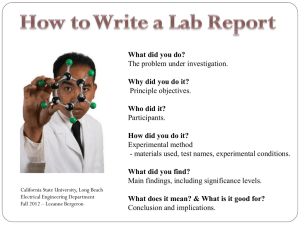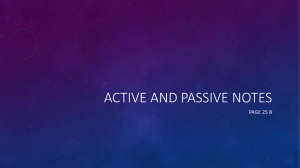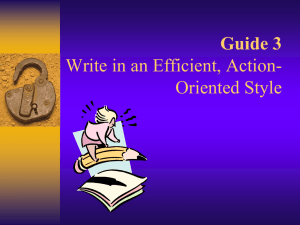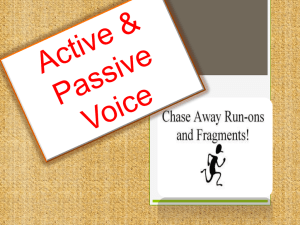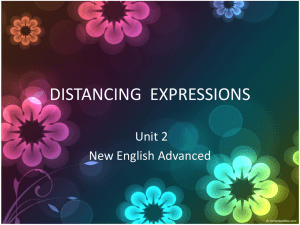Active and Passive Voice
advertisement
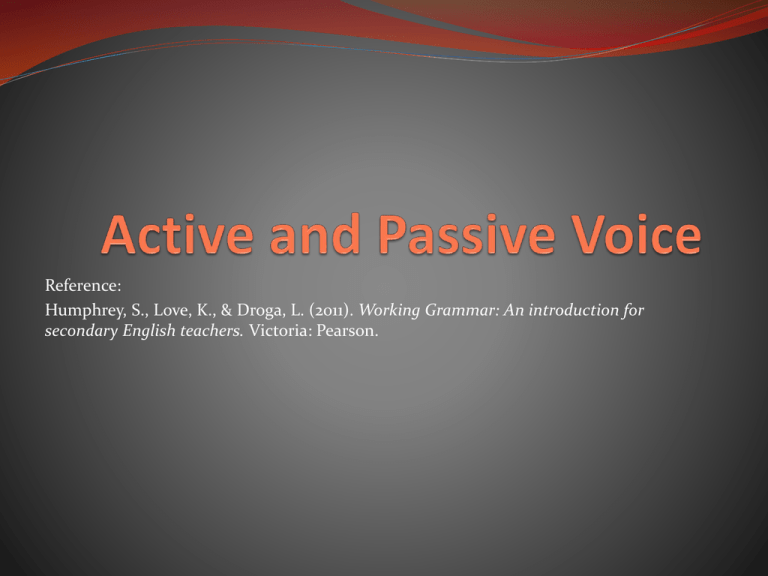
Reference: Humphrey, S., Love, K., & Droga, L. (2011). Working Grammar: An introduction for secondary English teachers. Victoria: Pearson. Definitions: Active voice: Verbs are written with the subject performing the process. e.g. ‘I read the paper.’ Passive voice: Verbs are written with the subject receiving the action expressed by the verb. e.g. ‘The paper was read’. Subject – the noun (or its equivalent) about which the sentence is written. It agrees with the verb. Object – the noun (or its equivalent) governed by an active verb or preposition. (Adapted from: Australian Concise Oxford Dictionary, 5th ed., 2009). Uses of active and passive voice Verbs are written in active or passive voice depending on the purpose of the writer or speaker. Active voice: • Is more immediate • Is more dynamic, energetic and engaging • The writer or speaker is expressing a direct relationship with the material they are writing/speaking about • The writer/speaker may be establishing a more familiar or ‘real’ connection with the audience • The writer/speaker may be taking personal responsibility for what they are talking/ writing about Passive voice: • The writer/speaker is distancing themselves from the material they are writing/speaking about • The performer of the action may be unknown • The writer/speaker wants to make the performer’s role less visible for a variety of reasons (political or sensitive subject matter, not taking personal responsibility for something, not wanting to name specific individuals or groups etc) • The written text/speech is formal Examples – Active/Passive Voice (Humphrey et al., 2011, p. 55) Active voice Passive voice We found the rainforest after a long day’s drive. Rainforests are found along the east coast of Australia. The timber company logs many of these These areas are logged by clearfelling rainforests. methods. The ancients in all their wisdom wrote these things down in their books. Books were written long ago about these things. The stockmen found the kids and herded and piled them onto the back of the truck. The kids were found … they were herded and piled onto the back of the truck. • In all the sentences in the Active voice column, the subject is the ‘doer’ of the process. • In the Passive voice column, the subject does not perform the action expressed by the verb group. Exercise 1 (Humphrey et al., 2011, pp. 56-57) Rewrite the following sentences in either active or passive form, depending on the gaps in the table. The first one has been done for you. Active voice Passive voice The drought completely destroyed their wheat crop last year. Their wheat crop was completely destroyed last year. Your files should be backed up at least once a week. The ruling government committed an injustice against the Stolen Generations. The country was ruled dictatorially for decades. The World Cup Soccer was successfully hosted in July 2010 in South Africa. The new desalination plant will endanger marine wildlife. Exercise 2 In the following text: 1. Underline all the verb groups 2. Identify whether each verb or verb group is using active or passive voice. 3. Describe either the effect, reason or purpose of the type of voice used for each verb or verb group. The time has now come for the nation to turn a new page in Australia’s history by righting the wrongs of the past and so moving forward with confidence to the future. We apologise for the laws and policies of successive Parliaments and governments that have inflicted profound grief, suffering and loss on these our fellow Australians… And for the indignity and degradation thus inflicted on a proud people and a proud culture, we say sorry. We the Parliament of Australia respectfully request that this apology be received in the spirit in which it is offered as part of the healing of the nation… We today take this first step by acknowledging the past and laying claim to a future that embraces all Australians. (From Kevin Rudd’s ‘Sorry Speech’ 2008) Answers The time has now come for the nation to turn a new page in Australia’s history by righting the wrongs of the past and so moving forward with confidence to the future. We apologise for the laws and policies of successive Parliaments and governments that have inflicted profound grief, suffering and loss on these our fellow Australians… And for the indignity and degradation thus inflicted on a proud people and a proud culture, we say sorry. We the Parliament of Australia respectfully request that this apology be received in the spirit in which it is offered as part of the healing of the nation… We today take this first step by acknowledging the past and laying claim to a future that embraces all Australians. Answers cont’d 1. ‘has now come’ – passive voice, formal opening to the apology all other verb groups in 1st dot point – active voice, the ‘nation’ is the doer of the actions and must take responsibility for the actions. 2. Both verb groups use the active voice – the doers of the actions are explicitly named. Taking personal responsibility for both us (‘we’) and the ‘successive Parliaments and governments’ of the past. 3. ‘thus inflicted’ – passive voice, distancing himself from personal responsibility for causing the actual pain. ‘say sorry’ – active voice, uses ‘we’, taking personal responsibility for apologising for the actions of past governments. A very clever strategy here – does not want to say that he caused the pain, but wants to apologise personally and actively for the pain caused by others (past governments). Answers cont’d 4. ‘respectfully request’ – active voice, immediate, personal engagement with the audience of Aboriginal people. Reaching out on a personal level to start to attempt the process of healing the relationship between the Aboriginal people and the government – an intensely personal process, so the active, personal voice is needed for the apology to have any real effect. All other verb groups in 4th dot point are passive – gives this part of the apology a formal gravity and seriousness to show the importance of the apology; is requesting the apology be accepted by the Aboriginal people as a whole – a serious and formal request, showing respect and dignity towards the Aboriginal people. 5. All verb groups active – personal, representing the government as ‘we’ and speaking about the active steps that ‘we’ as a government and as a nation will take. Reflection From the excerpt given from Kevin Rudd’s 2008 ‘Sorry Speech’, you can see that the use of active and passive voice in writing and speaking is strategic and can have profound effects on positioning an audience. For the following text types, identify one or more possible purposes for each and explain how active or passive voice may be appropriate to use for each and why. Just give one or two examples for each text type. Text type Diary entry Persuasive speech Formal speech Formal analytical essay (on a novel or set topic) Purpose(s) Active/Passive voice Why? Extension Choose one of the topics below and on that topic, write a short excerpt of a diary entry, persuasive speech, formal speech AND formal essay. In each excerpt, demonstrate: • the differing use of active and/or passive voice. • the different ways you can treat the same subject matter through different text types with different purposes and audiences in mind. Keep each excerpt short – and experiment with your use of language to meet the purposes and audiences you have in mind for each text type. TOPICS: •Education •Whales •Motorbikes •Surfing •Dogs •Logging •Oceans •Unsupervised parties •Underage drinking •Peer pressure •Speeding on our roads •Setting personal goals •Bullying in schools •Littering •Other: your own choice
